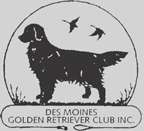Competing with your golden
There are a variety of activities to compete in with your Golden Retriever. Each forms a close bond between you and your best friend. Below are a few of the events available through the AKC.
Conformation:
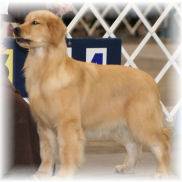 Conformation events are intended to evaluate breeding stock. The
size of these events ranges from large all-breed shows, with over
3,000 dogs entered, to small local specialty club shows, featuring a
specific breed. The dog's conformation (overall appearance and
structure), an indication of the dog's ability to produce quality
puppies, is judged.
Conformation events are intended to evaluate breeding stock. The
size of these events ranges from large all-breed shows, with over
3,000 dogs entered, to small local specialty club shows, featuring a
specific breed. The dog's conformation (overall appearance and
structure), an indication of the dog's ability to produce quality
puppies, is judged.
To be eligible to compete, a dog must:
- be individually registered with the American Kennel Club
be 6 months of age or older
- be a breed for which classes are offered at a
show
meet any eligibility requirements in the written standard for its breed
Spayed or neutered dogs are
not eligible to compete in conformation classes at a dog show,
because the purpose of a dog show is to evaluate breeding stock.
Obedience:
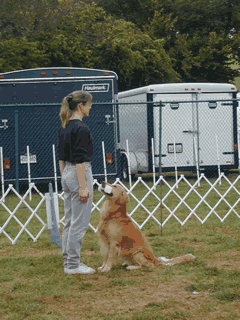 Obedience Trials test a dog's ability to perform a prescribed set of
exercises on which it is scored. In each exercise, you must score
more than 50 percent of the possible points (ranging from 20 to 40)
and get a total score of at least 170 out of a possible 200. Each
time your dog gets that magic 170 qualifying score, he's gotten a
"leg" toward his title. Three legs and your dog has become an
Obedience-titled dog! There are 3 levels at which your dog can earn
a title and each is more difficult than the one before it. You may
see levels divided into "A" and "B" at a trial; "A" classes are for
beginners whose dogs have never received a title while "B" classes
are for more experienced handlers.
Obedience Trials test a dog's ability to perform a prescribed set of
exercises on which it is scored. In each exercise, you must score
more than 50 percent of the possible points (ranging from 20 to 40)
and get a total score of at least 170 out of a possible 200. Each
time your dog gets that magic 170 qualifying score, he's gotten a
"leg" toward his title. Three legs and your dog has become an
Obedience-titled dog! There are 3 levels at which your dog can earn
a title and each is more difficult than the one before it. You may
see levels divided into "A" and "B" at a trial; "A" classes are for
beginners whose dogs have never received a title while "B" classes
are for more experienced handlers.
Novice: The first level, Novice, results in your dog earning a
Companion Dog (CD) title. The title actually describes what is
expected of your dog: demonstrating the skills required of a good
canine companion. The dog will have to heel both on and off leash at
different speeds, come when called, stay (still and quietly!) with a
group of other dogs when told, and stand for a simple physical exam.
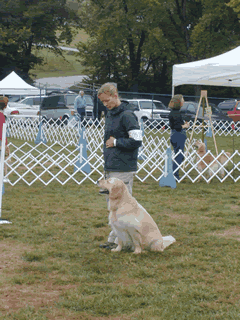 Open:
The second level, Open, results in your dog earning a
Companion Dog Excellent (CDX) title. He must do many of the same
exercises as in Novice, but off-leash and for longer periods.
Additionally, there are jumping and retrieving tasks.
Open:
The second level, Open, results in your dog earning a
Companion Dog Excellent (CDX) title. He must do many of the same
exercises as in Novice, but off-leash and for longer periods.
Additionally, there are jumping and retrieving tasks.
Utility: The final level results in a Utility Dog (UD) title. These
are the cream of the crop. In addition to more difficult exercises,
the dog also must perform scent discrimination tasks.
OTCH and UDX: The best of the best can go on for more titles.
Utility Dogs that place in Open B or Utility B classes earn points
toward an Obedience Trial Champion (OTCH) title. Utility Dogs that
continue to compete and earn legs in both Open B and Utility B at 10
shows receive the title Utility Dog Excellent (UDX).
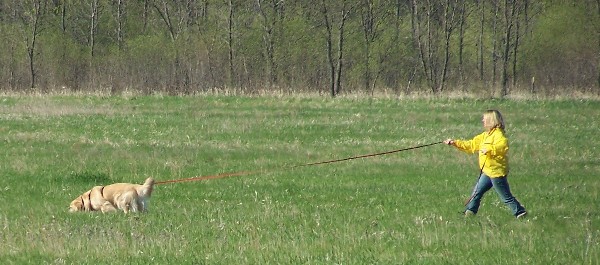
Tracking
AKC tracking events are the competition form of canine search and
rescue. These Tracking events provide training for dogs and their
handlers to meet some human needs for tracking and finding lost
humans or other animals, as well as, demonstrating the extremely
high level of scent capability that dogs possess.
We've all seen movies with dogs following the trail of an escapee
through swamps. The AKC's Tracking Tests allow dogs to demonstrate
their natural ability to recognize and follow human scent. This
vigorous outdoor activity is great for canine athletes. Unlike
Agility and Obedience events that require a dog to qualify three
times, a dog only needs to complete one track successfully to earn
each title.
Tracking Dog (TD)
A dog earns a TD by following a track 440 to 500 yards long with
three to five changes of direction. The track is laid by a human
tracklayer and is "aged" 30 minutes to two hours before the dog
begins scenting. The goal is to use the scented track to locate an
article left at the end of the trail by the tracklayer. The owner
follows the dog on a long leash and can encourage the dog during the
tracking test.
Tracking Dog Excellent (TDX)
The TDX is earned by following an "older" track (three to five
hours) that is also longer (800 to 1,000 yard) and has five to seven
directional changes with the additional challenge of human cross
tracks.
Variable Surface Tracking (VST)
In the real world, dogs track through urban settings, as well as
through wilderness. A VST dog has demonstrated this ability by
following a three- to five-hour-old track that may take him down a
street, through a building and other areas devoid of vegetation.
Champion Tracker (CT)
A dog that has successfully completed all three tracking titles (TD,
TDX and VST) earns the prestigious title of Champion Tracker.
Owners who do tracking with their dogs find joy in seeing the dogs
at work using their innate scenting skills. If you and your dog like
the outdoors, try tracking!
AGILITY
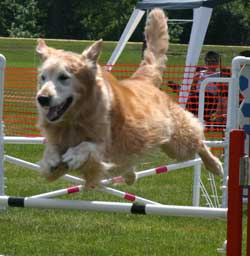 Agility
began as an exhibition sport in Great Britain and was imported to
the United States in 1977. The sport was patterned after equestrian
events and combines handler control, agility, and confidence. The
sport of agility is comprised of a course set up of many different
obstacles. Agility is meant to be a fun, non-regimented sport, with
a lot of spectator appeal. Obstacles include jumps, tunnels, a dog
walk, a see-saw or teeter, an A-frame and weave poles.
Agility
began as an exhibition sport in Great Britain and was imported to
the United States in 1977. The sport was patterned after equestrian
events and combines handler control, agility, and confidence. The
sport of agility is comprised of a course set up of many different
obstacles. Agility is meant to be a fun, non-regimented sport, with
a lot of spectator appeal. Obstacles include jumps, tunnels, a dog
walk, a see-saw or teeter, an A-frame and weave poles.
The rules are fairly simple; handlers may give an unlimited number
of commands or signals to their dogs, but may not touch either the
equipment or the dog. Dogs are 'faulted' for actions such as taking
down a jump bar, failing to put one or more feet in the safety or
contact zone when ascending/descending contact equipment, taking
obstacles out of sequence, and running past or stopping before the
next obstacle to be performed. Time penalties are additionally
assessed against dogs that exceed the SCT.
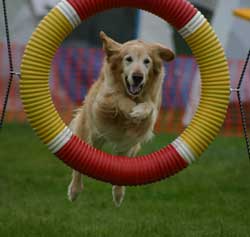
Dogs compete only against dogs of similar height at the withers
within a fixed number of jump height divisions. The number of height
divisions and the ranges of dog heights assigned to a height
division (and therefore the difficulty factor) differ considerably
from organization to organization. Regardless of the organization,
the dog with the lowest number of faults and the fastest time wins
the class or height division.
Field Events
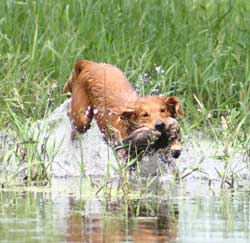 The
purpose of a field trial is to determine the relative merits of
Retrievers in the field.
The
purpose of a field trial is to determine the relative merits of
Retrievers in the field.
The function of a Non-Slip Retriever is to seek and retrieve
"fallen" game when ordered to do so. He should sit quietly on line
or in the blind, walk at heel, or assume any station designated by
his handler until sent to retrieve. When ordered, a dog should
retrieve quickly and briskly without unduly disturbing too much
ground, and should deliver tenderly to hand. He should then await
further orders.
Accurate marking is of primary importance. A dog which marks the
fall of a bird, uses the wind, follows a strong cripple, and will
take direction from his handler is of great value.
Tests for the GRCA Working Certificate shall be as follows:
1. Land Double. The retrieving of two UPLAND game birds (not a mixed
bag) on land in moderate cover with the birds approximately 40-50
yards from the line and the falls at least 90 degrees apart. For
uniformity in the land double, both birds may be shot and killed
prior to the start of the test. At the discretion of the judges, the
diversion bird may be a shot flier. Bird throwers should be in light
colored shirts or jackets. The use of "wingers" is prohibited in WC
tests.
2. Back to Back Water Singles. The retrieving of two freshly killed
ducks in swimming water in light cover with the ducks approximately
25 to 30 yards from the line. Bird throwers should be in light
colored shirts or jackets. Each dog should retrieve at least one
"new" duck. Previously used birds are to be avoided unless
absolutely necessary.
GUIDELINES
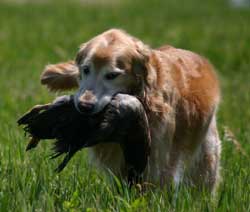
The WC test is not intended to test the degree of training but
rather to demonstrate the natural ability of the dog to perform
normal hunting tasks. The double on land demonstrates the ability to
mark and retrieve two birds and tests the memory of the dog. The
back to back water singles demonstrate the ability to swim, to
retrieve a waterfowl, and a willingness to re-enter the water. There
is no competition between dogs in this test. The handler is expected
to come to the line quietly with his dog under control at his side.
The dog may be brought on leash or slip cord, but these must be
removed during the test. The dog may run with a collar and may be
held with the leash or slip cord until he is sent by the handler.
After the judge has called the dog's number and the dog has been
sent, the handler should stand quietly on line while the dog is
working. No voice commands nor hand signals are allowed. These are
marking tests; handling is not permitted.
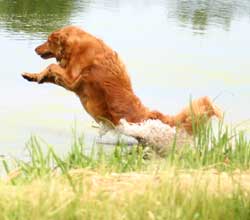 When
the dog has returned with his first bird on the land double, the
handler may pat his side or speak to his dog by name, telling him to
heel, sit, stay, etc., thereby getting the dog ready and lined up to
go for the second bird. The handler may not take his dog by the
scruff of the neck and pull him into position before sending him for
the second bird. He may gently guide the dog by the collar to get
his attention and steady him before sending him.
When
the dog has returned with his first bird on the land double, the
handler may pat his side or speak to his dog by name, telling him to
heel, sit, stay, etc., thereby getting the dog ready and lined up to
go for the second bird. The handler may not take his dog by the
scruff of the neck and pull him into position before sending him for
the second bird. He may gently guide the dog by the collar to get
his attention and steady him before sending him.
After the dog has retrieved the second bird, the handler may take
the dog by the collar and lead him off the line. In each of the
water singles, the handler may hold the dog until his number is
called by the judge.
